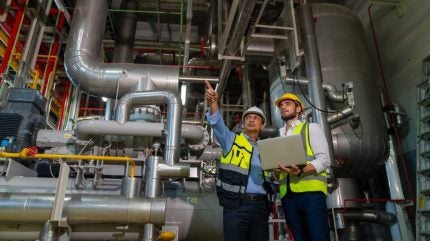
Process vessels and industrial boilers provide essential manufacturing infrastructure in many heavy industries, including oil and gas, pulp and paper, chemicals, and waste management. However, media processed inside these vessels can often be corrosive in nature. For example, in amine process equipment, carbon steel surfaces may be attacked by water vapour condensation and the formation of carbonic acid. Additionally, these components often face high temperatures and frequent use, which can further result in erosion and stress cracking.
Maintaining asset integrity is essential to ensure the safety and reliability of vital equipment is not compromised. Yet addressing corrosion and metal wastage can often result in hefty repair and replacement costs. Moreover, the cost of shutting down equipment for repair, especially unexpectedly, can cost companies billions in terms of production costs. According to a report from Siemens, unplanned downtime costs Fortune 500 companies 11% of their annual turnover – almost $1.5 trillion.[i]
Traditionally, welding has been deployed to address corrosion problems, but this hot process can put extra stress on equipment and typically requires pre- and post-weld heat treatment. High-velocity thermal spray (HVTS) is emerging as an innovative alternative solution to provide a faster and equally durable on-site corrosion mitigation for process vessels and boilers.
Welding versus thermal spray: pros and cons
Corrosion ultimately leads to metal wastage and shell thickness loss, which must be identified sooner than later lest the minimum corrosion allowance be exceeded. Welding is often used as a common solution to repairing equipment that is not beyond repair. In this process, wall thickness is rebuilt with a corrosion resistant alloy (CRA), which also improves pressure retention.
However, overheating during the welding process can cause great stress on thinner vessels, resulting in shrinkages of approximately 1%. On a 5m diameter column, this would result in significant distortion of 50mm. Additionally, welding is a time-consuming process that could leave essential equipment in repairs for weeks. Removing and reinstalling support rings and downcomers alone can double the duration of any welding project, which can further be complicated by the skill of the welding technician at hand.
But most importantly, weld overlay repair does not address the root of the issue and will in time be corroded in the same way as the material underneath. The exercise of repairing process vessels and boilers using this method must be repeated every few years, resulting in significant equipment downtime and financial losses.
Thermal spray technology has been used to apply CRA since the 1980s, but welding has previously been favoured to rectify corrosion issues because the thermal spray process itself was rendering the resulting cladding more permeable. However, modern iterations of the thermal spray equipment have innovated to eliminate these deficiencies, instead applying cladding through a high-velocity process that creates an impermeable barrier.
A modern High-Velocity Thermal Spray solution
In High-Velocity Thermal Spray (HVTS), specific processes and chemicals are employed to prevent cladding particles from oxidising in-flight, which prohibits the creation of permeable pathways on deposition. This process allows cladding to be applied within days, significantly reducing turnaround time as opposed to welding, all without inducing any additional thermal stress on the equipment. While HVTS alone does not improve the structural integrity of equipment, in situations where the vessel has not passed the Fitness for Service (FFS) test, it can be applied after welding to prevent corrosive media from attacking the underlying substrate and provide a significant boost to equipment lifespans.
Pioneered by IGS, the tech has already seen a variety of applications across industries. In 2011, IGS partnered with a Qatar-based gas plant to rectify severe pitting in its gas processing equipment. During a January 2023 inspection, years after the HVTS application, protected vessels were still found to be in excellent condition.
Another successful case study for HVTS can be found in Switzerland, where a waste to energy plant was experiencing fireside corrosion. The plant provides electricity for more than 44,000 households, as well as local plants with steam and hot water. IGS was contracted to apply an HVTS cladding on top of the weld overlay, which was showing signs of premature accelerated degradation. After ten months in service, the IGS thermal spray showed no defects, and the HVTS solution was applied again to other areas of Alloy 625 exhibiting signs of wear and degradation. Six years later, IGS HVTS cladding continues to protect waterwalls from high-temperature molten salt corrosion.
In its modern form, high-velocity thermal spray has become a trusted method to protect industrial equipment from erosion and corrosion, offering significant advantages over welding in terms of speed of application, alloy suitability, longevity, on-site deployment, back-to-service time, and commercial rates of return. IGS have developed HVTS for application in high-pressure, high-temperature equipment.
To learn more about HVTS and other IGS solutions, download the free report below.
[i] https://assets.new.siemens.com/siemens/assets/api/uuid:3d606495-dbe0-43e4-80b1-d04e27ada920/dics-b10153-00-7600truecostofdowntime2022-144.pdf


